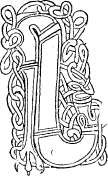
CHAPTER VIII.
LEGES MINORES
SECTION I.
Marriage in Ancient Ireland

OGICALLY the subject of Marriage should have been discussed in connection with the account of the clan system. But not being essential to that account, its introduction there would have further confused a subject already sufficiently obscure.
Under the clan system one would expect to find the marriage laws very important and clearly laid down; yet, notwithstanding the domestic familiarity of the laws, the information given on the marriage relation is surprisingly scanty, and of a disappointing character too. The ancient Celtic family was not constructed like the modern Christian family, and it retained its form for some time after the people had become Christian. What precisely that form was, and what the principle of construction, being matters involved in our lack of knowledge of the clan system, are now subjects of more or less wild conjecture. My own impression is that in reference to the small private circle which we should call the family, it is not so much knowledge of the thing itself we lack as knowledge of the manner in which the clan organisation produced such a condition of things that the law was rarely invoked in matters which are of frequent occurrence in modern litigation.
So far as the laws show, the marriage relation was extremely loose, and divorce was as easy, and could be obtained on as slight grounds, as is now the case in some of the States of the American Union. It appears to have been obtained more easily by the wife than by the husband. When obtained on her petition, she took away with her all the property she had brought her husband, all her husband had settled upon her on their marriage, and in addition so much of her husband's property as her industry appeared to have entitled her to. This latter would be little or nothing if she had been an idle woman, a considerable amount if she had been a good housewife and producer of wealth. It was estimated in various ways according to circumstances. Supposing there was a quantity of flax or wool on the premises, if this remained in the raw state until the woman obtained her divorce she could take away none of it unless she was able to establish a claim in some other way, which she might do up to the value of one-eighth of the raw material. If by her industry she had it "in locks," she was entitled to take away one sixth of it; if combed, one-third; and so on; the assumption being that she had made these improvements. In making these calculations various matters of set-off arose with which we need not trouble ourselves here. The law seems to contemplate a woman being divorced from her husband and marrying him again, and even doing this more than once. Possibly divorce is a redundant translation, that the marriage was not considered completely dissolved, and that separation would be more nearly correct.
According to these laws a man might purchase a wife; from which it would follow that what a man might buy he might also sell. The English laws of Æthelbirht and of Ine distinctly provide for the buying of a wife. The Irish laws have much more to say about the abduction than about the purchase of wives. The laws recognised three relations between men and women. In the first of these stood "a first lawful wife;" in the second "a first lawful adaltrach-woman;" in the third "an adaltrach-woman of abduction." All were legal relations, and could not be dissolved except by the will of both parties or by legal process. These relations are not defined; but I believe that the first was the only one that had a religious sanction, and that the second and third were merely civil relations, the third being distinctly stuprous and of itself scarcely conferring any right.
Apparently the law on marriage and the dissolution of marriage was wholly pagan, and never underwent any modification in Christian times; perhaps because it was little resorted to except by the wealthy, and they had sufficient influence to keep it unaltered. Besides, it is impossible to know how we may err in attempting to apply laws to a form of society which we do not understand. I am convinced that the law on this subject must not be taken as presenting a true picture of ancient Irish life, not because the picture is an unfavourable one, but because outside the laws there is overwhelming evidence that this legal picture is unjust, that singular purity characterised the Irish in the past as in the present, and that women occupied in ancient times a position as honourable as they occupy now. It is one of the many cases in which the law is more concerned with the few who invoke it than with the many who never invoke it during their lives. Probably all the value that should be attached to the law on this subject is that it marks the extreme limit of libertinism.

